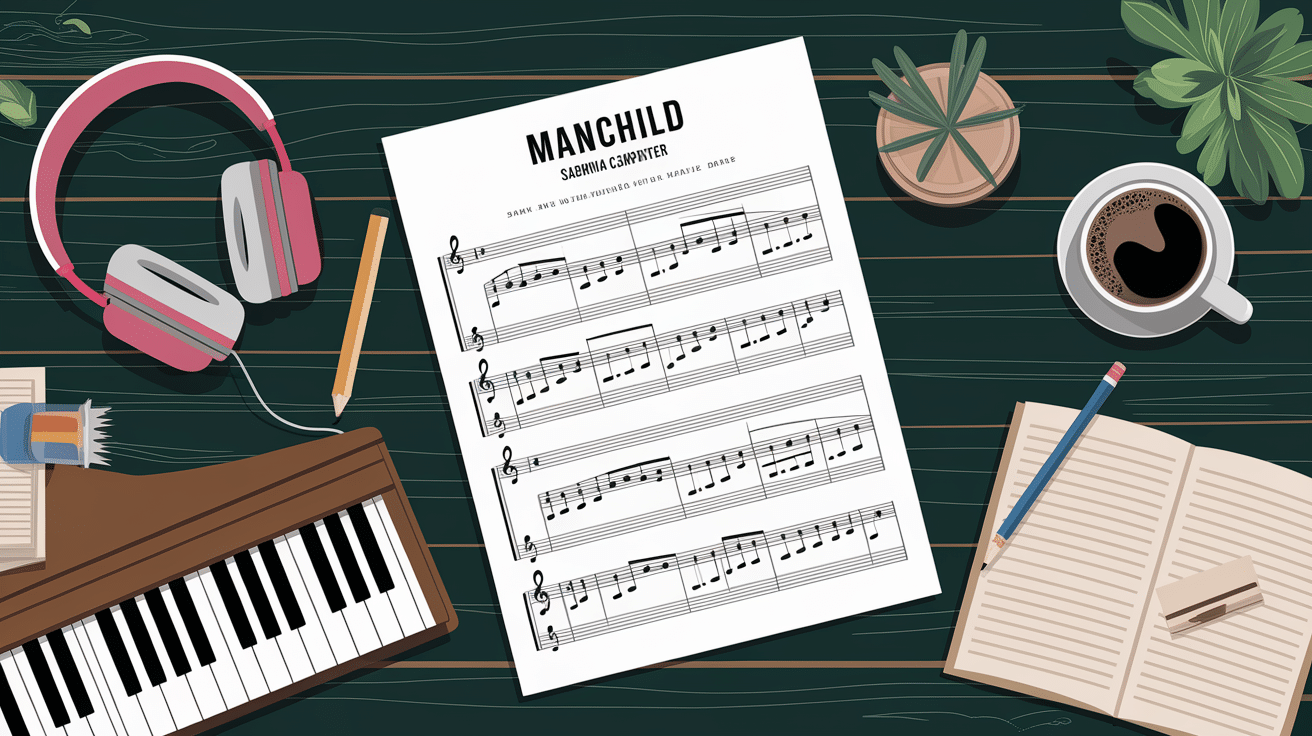In a world where intricate musical compositions often overshadow the simplicity and joy of three-chord songs, “Manchild” stands as a testament to the beauty of straightforward songwriting. This gem by the iconic band, ‘The Royal Concept’, encapsulates the essence of youthful exuberance and emotional insight, all within the confines of just three chords.
But what if I told you that mastering such a song could unlock not only your guitar-playing abilities but also your appreciation for melody and lyrical depth? Whether you’re a seasoned musician or a novice strumming your first notes, the allure of “Manchild” can inspire you to dive deeper into the heart of music.
The relevance of mastering “Manchild” extends beyond mere performance; it’s about connecting with the very pulse of what music represents—a canvas for raw emotion, a medium for storytelling, and an opportunity for self-expression. In today’s fast-paced world, where complexity often seems to reign supreme, this song invites you to slow down and embrace simplicity. With just three chords, you can evoke feelings of nostalgia, joy, and even a hint of rebellion against the mundane. Imagine strumming the vibrant rhythms of “Manchild” at a gathering, instantly creating an atmosphere where everyone sings along and shares in a collective memory. It’s more than just learning notes; it’s about creating moments.
But why should you care about mastering a song that some might consider trivial in the grand spectrum of music? The answer lies in the power of accessibility. By focusing on three simple chords, you’re not only enhancing your skills but also placing yourself at the heart of the music-making experience. Many of today’s greatest songs are built on simplicity, and understanding how to navigate this space can radically transform your musical journey. “Manchild” serves as an excellent starting point; its infectious melody and relatable lyrics provide a unique opportunity to explore creativity while keeping the joy of playing at the forefront.
So, if you’re ready to unlock the door to a world where simplicity reigns and creativity flows, grab your guitar and prepare to dive into the enchanting universe of “Manchild.” With our step-by-step approach, you’ll discover not just how to play this iconic tune but also how to tap into your own artistry, ultimately gaining confidence in your abilities. Whether you’re looking to impress friends around a campfire or reminisce about carefree days, let’s embark on this journey together—because every great musician knows it’s not about the complexity of the chords, but the heart you pour into each strum.
Unleashing the Power of Three Chords for Manchild by Sabrina Carpenter
Leveraging just G major, A minor, and C major in “Manchild” gives you a unique opportunity to focus deeply on expression and nuance rather than complexity. By consistently returning to this simple triad sequence, you create a solid foundation that enhances your control over dynamics and timing. For instance, experimenting with how long you hold the G major chord at the start of each verse line can dramatically change the mood, drawing listeners into the narrative with each subtle shift. Additionally, the interplay between the minor tonality of A minor and the bright resolution of C major offers a natural emotional ebb and flow, making the progression feel both familiar and compelling despite its minimalism.
Download Licensed Digital Sheet Music

The Anatomy of “Manchild”
Every element of “Manchild” is designed around simplicity that fosters expression. The song’s structure feels almost hypnotic thanks to the unwavering repetition of its core chord progression, inviting you to explore subtleties rather than chord complexity. This restrained palette allows you to focus on tone, dynamics, and phrasing, transforming what could be a basic accompaniment into a rich, emotive performance. The interplay between left and right hands adds depth, where the bass notes anchor the harmony while the upper voices in the right hand color the chords with inviting warmth.
Since the progression never shifts, the song becomes a canvas for creative interpretation. Whether you’re emphasizing rhythmic variations or experimenting with dynamics, the foundation stays constant, making learning both accessible and rewarding. In the bridge, slight alterations, like moving an octave higher or softer playing, give you the tools to build tension and release without changing a single chord. This opens doors to personal expression within the simple framework.
Chord Breakdown: G Major, A Minor, and C Major
The three chords you’ll be playing form the backbone of “Manchild” and each shows distinct characteristics that contribute to the song’s mood. The G major chord employs G and D in the left hand, providing a strong bass foundation, while the right hand plays G, B, and D, creating a full, bright sound. This chord conveys a hopeful, grounded feeling that naturally leads the progression.
Moving to A minor, you’ll place A and C in the left hand, with A, C, and E in the right. This chord introduces a subtle emotional shift thanks to its minor tonality, lending a gentle hint of melancholy to the sequence. Finally, the C major chord combines C and G in the left hand with C, E, and G in the right, producing a warm, resonant sound that rounds out the progression with a sense of resolution. Mastering these voicings ensures that each chord’s character comes through clearly as you play.
Understanding the Chord Progression Throughout the Song
The unchanging progression of G major to A minor to C major runs from start to finish, shaping the entire song’s identity. Your left hand anchors this cycle with alternating bass notes that provide a rhythmic pulse, while the right hand carries the full chord voicings. In the verses, the G major chord holds steady during the first phrase, creating a stable opening before the progression moves to A minor and then resolves with C major in the next phrase. This repeated phrase structure adds to the hypnotic effect, making the melody easier to follow and the entire song feel cohesive.
Beyond just repeating chords, the progression’s predictability lets you focus on subtle techniques like timing shifts or dynamic contrasts. For instance, maintaining a block chord approach during the verses sets a solid foundation, but switching to arpeggiated chords in the chorus can make the section feel more lively. This rhythmic flexibility invites you to tailor the emotional pacing as you build towards the bridge where the octave shift amplifies the impact without altering the chord sequence itself.
Throughout the song, the chord progression serves as an anchor, allowing your expression to shine through changes in rhythm, dynamics, and registration. By fully internalizing this cycle, you can effortlessly transition between sections while maintaining musical interest, proving that minimalism can be incredibly powerful in piano playing.
Embodying the Rhythm: Techniques for Expression
You can bring “Manchild” to life by focusing on the rhythm and how you articulate each chord within the repetitive progression. Holding the G major chord steady during the first phrase of a verse line sets a grounding pulse, creating space for the A minor and C major chords to add subtle movement and emotional nuance. Playing with a gentle but consistent pulse allows the song’s melancholic yet hopeful tone to resonate clearly, especially when you blend a steady left hand bass with a more expressive right hand melody or harmony. Dynamics play a significant role here; slightly emphasizing the transition from G major to A minor gives the progression a natural ebb and flow, inviting listeners into the story the song conveys.
Experimenting with timing is another way to embody the rhythm. Slightly delaying the chord changes or adding a rubato feel can soften the repetitive nature of the song, turning it into a more personal performance. For example, by elongating the first G chord just a touch before moving into the A minor and C chords, you create anticipation that keeps the listener engaged. These subtle rhythmic variations allow you to personalize the progression without altering the chords themselves, preserving the song’s accessibility while deepening its emotional impact.
Exploring Variations: From Blocked to Arpeggiated Chords
Starting out with blocked chords keeps your playing simple and clean, especially as you familiarize yourself with the three-chord cycle. When you play blocked chords, your left hand anchors the progression by hitting the root and fifth (for example, G and D for G major), while your right hand fills in the triad. Once you’re comfortable with this, introducing arpeggios or broken chords can add texture and interest. Playing the notes of each chord one after the other—such as G, B, and D in succession—creates a flowing, harp-like effect that contrasts nicely with the straightforward nature of the song.
As you explore these variations, you might also incorporate rhythmic patterns like eighth-note arpeggios or syncopated broken chords to evoke a more contemporary feel. Because the harmonic content stays the same, these subtle shifts in articulation can transform the overall mood. Arpeggiated chords can highlight the song’s delicate synth-inspired backing, while blocked chords emphasize its straightforward, sing-along quality. Choosing when to apply each style depending on the section—perhaps blocked chords during verses and arpeggios during the chorus or bridge—helps build dynamic contrast without adding complexity.
Finding Your Groove: Adapting Rhythm for Personal Style
Adjusting the rhythm to suit your personal playing style can make a notable difference in how “Manchild” feels and connects emotionally. The original track uses a mix of sustained synth notes and syncopated patterns, which may be challenging to mirror exactly on piano. Instead, you can develop a groove that fits your comfort zone—whether that’s a straight, metronomic pulse or a gently swung rhythm. Adding light syncopation, especially in the right hand’s chord voicing, can inject subtle momentum, while leaving the left hand steady provides balance.

Building your own groove also means considering how the rhythmic choices suit your technical abilities and expressive goals. If your aim is to convey intimacy, slow down the tempo and use a gentle touch, emphasizing the warmth of the chords. For a more upbeat or pop-oriented rendition, introduce syncopated rhythms or accent off-beats to energize the progression. The song’s simplicity invites you to experiment freely—every subtle rhythmic adjustment contributes to crafting a version that feels authentically yours.
Dynamic Elevation: Crafting Your Unique Sound
Shaping the emotional contour of “Manchild” is less about adding complexity and more about how you manipulate the existing elements. The simplicity of the chord progression invites you to explore dynamics, touch, and register shifts rather than relying on extra notes or embellishments. Playing the chords with varying intensity—starting softly in the verses and building to a more emphatic chorus—can create a compelling narrative arc that aligns perfectly with the song’s lyrical mood.
Experimenting with rhythmic patterns also plays a key role in personalizing the performance. Subtle changes in how you release or hold keys, incorporating legato phrasing or staccato accents, allow you to infuse the piece with your individual musicality. The original synth textures might be challenging to mimic, but your adaptation of the piano rhythm can replace that layer, giving “Manchild” a fresh, expressive voice tailored to your style.
Building Emotion Through Octave Shifts
The bridge section offers an ideal moment to employ octave shifts for dramatic effect. Beginning in the middle C octave grounds the listener in the song’s familiar warmth, but shifting the same chord progression up one octave during a repeated phrase instantly energizes the sound and heightens emotional tension. This technique is especially effective in maintaining interest over the repetitive chord sequence without requiring new chords or melodies.
Moving the chords to a higher register accentuates their brightness and can give your rendition an uplifting or urgent quality. Since the song’s harmony doesn’t change, the contrast created by this octave jump stands out clearly, making the bridge feel like a natural climactic point. You can reinforce this effect by playing with increased touch sensitivity or a slight crescendo as you ascend, making the shift feel like a purposeful emotional elevation.
Enhancing Texture with Voicing Variations
Altering chord voicings unlocks another layer of expression within “Manchild.” Instead of playing all chord tones simultaneously in a block, you can prioritize certain notes or omit others to create subtle textural shifts. For example, in the G major chord, emphasizing the B note in the right hand adds a sweeter, more lyrical quality, while leaning into the D gives a brighter, more percussive sound. In A minor, voicing the chord with the E on top brings out the minor’s melancholic nuance more vividly.
You might also experiment with spacing—leaving wider gaps between your left- and right-hand notes to create openness or bringing notes closer together for a more condensed, intimate feel. These micro-adjustments can alter the color of the chords and the overall atmosphere, offering fresh perspectives on the repeated progression. Voicing becomes a subtle storytelling device, turning a simple three-chord cycle into an evolving soundscape.

The Practice Pathway: Building Confidence and Skill
Mastering “Manchild” hinges on gradually internalizing its simple chord progression while experimenting with dynamics and rhythm to enhance expressiveness. Repetition forms the backbone of your practice, with each cycle of G major, A minor, and C major chords reinforcing muscle memory and familiarizing you with the song’s cyclical nature. By focusing first on clean transitions between the chords—especially in the verse where the G major chord is sustained before moving through A minor and C—you establish a steady foundation that makes the rest of the piece flow naturally.
Developing skill also means exploring the stylistic elements that personalize your rendition. For example, you might begin by playing blocked chords to get comfortable, then gradually introduce arpeggios or syncopated rhythms to mirror the song’s subtle synth textures. The bridge section presents a perfect opportunity to build confidence through dynamic and octave shifts, adding emotional depth without complicating the underlying chord structure. This balance between repetition and variation creates a satisfying learning curve that keeps you engaged and progressing steadily.
Step-by-Step Learning: Breaking Down the Sections
| Section | Focus Points |
|---|---|
| Introduction | Start by playing the G → Am → C progression slowly with blocked chords, concentrating on accurate finger placement for each chord in both hands. Focus on a steady tempo to set the pace. |
| Verses | Maintain the same progression but hold the G major chord throughout the first phrase line. Practice the division of the second phrase between A minor and C major, aiming for smooth chord changes with minimal gaps. |
| Chorus | Apply slight rhythmic variations and experiment with voicing in the right hand, optionally using arpeggios to mimic the synth patterns. Emphasize starting on G major and resolving on C major for a natural flow. |
| Bridge | Introduce octave shifting by playing the section once in the middle C register, then repeating it one octave higher. Use dynamic contrasts (soft to loud) here to increase emotional intensity without changing chords. |
Breaking the song into these clear segments allows you to focus on manageable chunks, avoiding overwhelm. Each area emphasizes slightly different technical and expressive skills, making your practice balanced and comprehensive.
Strategies for Mastery: Overcoming Common Challenges
Transitioning between chords smoothly in the verse, especially maintaining the G major chord across a phrase before switching, can initially disrupt your rhythm if you rush. Tackling this requires slow practice with a metronome, where you hold the G chord precisely as indicated, then move deliberately to A minor and C without hesitating. Recording yourself can highlight timing inconsistencies that are easy to miss during practice.

Employing these targeted strategies will not only smooth out technical hurdles but will also encourage you to infuse your performance with nuance. This methodical approach transforms a seemingly simple chord progression into a dynamic and expressive piece, reinforcing your confidence and musicality as you master “Manchild.”
Sabrina Carpenter – Manchild Piano Tutorial
To wrap up
As a reminder, mastering “Manchild” with its three simple chords—G major, A minor, and C major—is well within your reach, regardless of your skill level. By focusing on the consistent chord progression and practicing the specific hand placements for each chord, you can build confidence quickly. You have the flexibility to start with basic blocked chords and gradually introduce variations such as arpeggios or rhythmic syncopations as you become more comfortable. This song’s repetitive structure allows you to perfect your timing and develop a natural flow without getting overwhelmed by complexity.
To elevate your performance, consider experimenting with dynamics and octave shifts, especially in the bridge, where you can create emotional contrast by playing higher registers. Adjusting the rhythm to suit your style will make the piece feel more personal and expressive. By approaching “Manchild” with patience and consistent practice, you’ll find that the song not only becomes easier to play but also offers room for your own interpretation and creativity, making it a rewarding piece to add to your piano repertoire.
